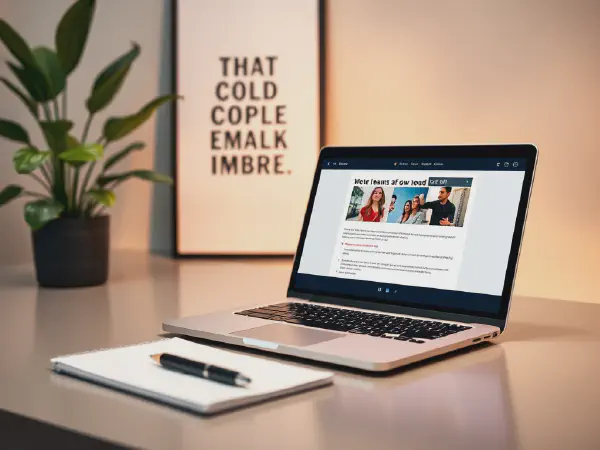Effective Cold Call Email Examples to Boost Sales

Cold Call Email Examples: Unlocking the Secrets of Effective Outreach
Cold call emails are a powerful tool in the world of sales and marketing. These emails allow businesses to reach out to potential clients or customers who may not have been previously aware of their services or products. However, crafting the perfect cold call email can be a challenge. This article explores various cold call email examples and provides tips on how to create compelling outreach that converts leads into sales.
Understanding what makes an effective cold call email is essential in today’s competitive market. Cold call email examples vary in style and approach, but they all aim to capture the attention of the recipient quickly. The key components include a strong subject line, personalized messaging, and a clear call to action. Businesses that implement effective cold call strategies can significantly increase their outreach efforts and improve their response rates.
In this article, we will delve into the intricacies of crafting cold call emails. We will highlight the importance of targeting the right audience and maintaining follow-up strategies to keep the conversation going. By analyzing cold call email examples across different industries, readers will gain insights into what works and what doesn’t. Furthermore, we will discuss legal considerations that should not be overlooked when sending cold emails.
Cold call email examples often come with varying tones, whether formal or casual, depending on the industry and audience. This diversity allows businesses to experiment and find their unique voice. Moreover, the ability to personalize these outreach emails can enhance their effectiveness, leading to better engagement with potential clients. To maximize outreach efforts, businesses must continually refine their approach based on real-world feedback and testing.
For effective outreach strategies, consider implementing proven techniques illustrated through various cold call email examples that drive results.
Ultimately, successful cold call emails can lead to fruitful conversations, partnerships, and increased business opportunities. As we explore various cold call email examples within this article, we will provide practical tips and best practices that can be employed to enhance your outreach strategy and drive results.
Crafting Cold Call Emails: Tips and Techniques
When crafting cold call emails, the subject line plays a crucial role in determining whether the email gets opened. A compelling subject line should be concise, intriguing, and relevant to the recipient's interests. For instance, instead of using generic phrases like 'Great Offer,' try something specific like 'Boost Your Sales by 20% with Our New Tool.' This creates curiosity and encourages the recipient to open the email.
Personalization is key in cold call emails. Utilize the recipient's name, mention their company, and reference their specific needs or pain points. This shows that you've done your homework and are genuinely interested in providing a solution. For example, an email that starts with, 'Hi John, I noticed your company is expanding rapidly and may benefit from our scalable solutions,' is much more effective than a generic greeting.
Structure is another essential element in cold call emails. Start with a strong opening that captures attention, followed by a brief introduction of who you are and what you offer. Clearly outline the benefits of your product or service, and conclude with a clear call to action. Avoid long paragraphs; instead, use bullet points for easy readability. This helps to keep the recipient engaged without overwhelming them with information.
Key elements to include in a cold call email are an engaging subject line, a personalized greeting, a clear value proposition, and a strong call to action. It's also pertinent to include social proof, such as testimonials or case studies, which adds credibility. Instead of just stating what you offer, illustrate how it can make a significant impact on the recipient's business.
For a strong call to action in your emails, be precise about what you want the recipient to do next. Whether it’s scheduling a meeting, visiting your website, or responding to your email, make it clear and, if possible, provide multiple options. Use language that creates urgency, like 'Let’s chat this week to see how we can work together,' to motivate recipients to take action immediately.
Targeting the Right Audience for Cold Calls
Researching your target audience is foundational for sending effective cold call emails. Understanding their interests, needs, and pain points enables you to tailor your message. Use social media, professional networks, and relevant industry websites to gather insights that can inform your communications. The more you know about your target audience, the more relevant your message will be.
Segmenting your cold email list is critical for improving response rates. By categorizing potential leads based on demographics, industry, or behavior, you can send more personalized emails. For example, a startup in the tech industry might require a different approach compared to a well-established firm in pharmaceuticals. Segmentation allows you to address specific needs and concerns more effectively.
Understanding customer pain points can help shape your message and demonstrate empathy. Research the common challenges faced by your target audience and position your product or service as a solution. A cold call email that addresses an issue directly, such as, 'We know how challenging cybersecurity can be; here's how our service can protect your operations,' is more engaging and likely to get a response.
Using analytics to refine your audience targeting can significantly improve your cold call emails' effectiveness. Platforms like Google Analytics or CRM systems provide valuable data on customer interactions. Analyzing this data helps you identify patterns and preferences, allowing you to refine your targeting strategy and enhance engagement over time.
There are several tools available to identify potential leads for your cold call emails. Platforms like LinkedIn Sales Navigator, Hunter.io, and ZoomInfo can help you find decision-makers within your target companies. Leveraging these tools allows you to build a more targeted and efficient email list, increasing the likelihood of successful outreach.
Follow-Up Strategies After Cold Emails
Timing your follow-up cold call emails is crucial. After sending the initial email, wait for a few days before checking in. Generally, a week is an ideal timeframe, but this can vary based on industry norms. Be mindful not to come off as pushy; a gentle reminder helps keep the conversation alive without overwhelming the prospect.
Crafting effective follow-up messages is key to maintaining interest. Reference the initial email and restate your value proposition in a concise manner. Adding new information or resources, such as a case study or testimonial, can also spark interest. For example, 'I wanted to share how we helped a client improve their sales—I'd love to discuss how we can achieve similar results for you.'
Measuring responses and engagement is vital to understand the impact of your cold call emails. Monitor metrics such as open rates, click-through rates, and reply rates to gauge effectiveness. These insights can dictate whether you need to adjust your approach or explore different messaging strategies to boost engagement.
Knowing when to give up on a lead is essential to optimize time and resources. If a prospect has not responded after three follow-ups over a few weeks, it may be best to move on. However, don’t burn bridges; a polite email stating you appreciate their time and are available for future discussions can keep the door open for later opportunities.
Using A/B testing for follow-up emails can yield valuable insights. This involves sending two versions of an email to different segments of your audience to see which performs better. Test various elements—like subject lines, email copy, call-to-action phrases—to identify what resonates most with your audience for future campaigns.
Cold Email Templates to Consider
Successful cold call email templates often follow a structured format. For instance, start with a personalized greeting, followed by an engaging subject line. Use clear language to introduce yourself, highlight the purpose of your email, present your value proposition, and conclude with a call to action. These templates save time and can be customized for different audiences.
Industry-specific cold email examples can provide inspiration for your outreach. For tech companies, emphasize innovative solutions and technology benefits. In contrast, for the health sector, focus on patient care and outcomes. Understanding industry nuances allows for tailored messaging that resonates with potential clients.
Customization tips for templates include using the recipient's name and referencing specific details about their company or industry. Rather than sending the same template to everyone, small changes can make a significant difference in engagement. Additionally, experiment with tone and language that aligns with your audience's preferences.
Analyzing templates for effectiveness involves reviewing which formats and styles yield the best responses. Maintain a list of templates used in previous campaigns, track their success rates, and refine them based on feedback. Continuous improvement and adaptation are crucial for ongoing success in cold email outreach.
Creating a library of cold call email examples can help streamline your process. Collect successful templates from various campaigns, document their performance metrics, and categorize them by industry, tone, and purpose. Having a repository of proven cold email examples provides a valuable resource for future outreach strategies.
Legal Considerations for Sending Cold Emails
To navigate the landscape of cold call emails, it’s vital to understand email marketing laws and regulations. Familiarize yourself with legislation like the CAN-SPAM Act in the U.S. and the GDPR in Europe. Compliance with these laws ensures that your outreach is legal and ethical, protecting both your business and recipients' rights.
Crafting compliant cold call emails involves including essential elements such as a clear unsubscribe option, company name, and address. Ensure that your messaging clearly states the purpose of the email and avoids misleading information. Transparency builds trust with your audience and enhances brand reputation.
The importance of opt-out options in cold emails cannot be understated. Providing recipients with a simple way to unsubscribe is not just a legal requirement; it respects their preferences and fosters goodwill. Include a clear opt-out link at the bottom of your email to allow recipients to easily manage their preferences.
GDPR considerations are especially crucial for businesses looking to engage with European customers. Ensure that you have obtained consent from individuals before sending marketing emails. Compliance includes clear documentation on how you plan to process and store personal data, emphasizing transparency in your outreach efforts.
Best practices for ethical email marketing revolve around consent, transparency, and respect. Always prioritize building relationships over mere transactional outreach. By providing valuable content, relevant offers, and respecting recipients' privacy, businesses can build a positive reputation that fosters long-term success.
